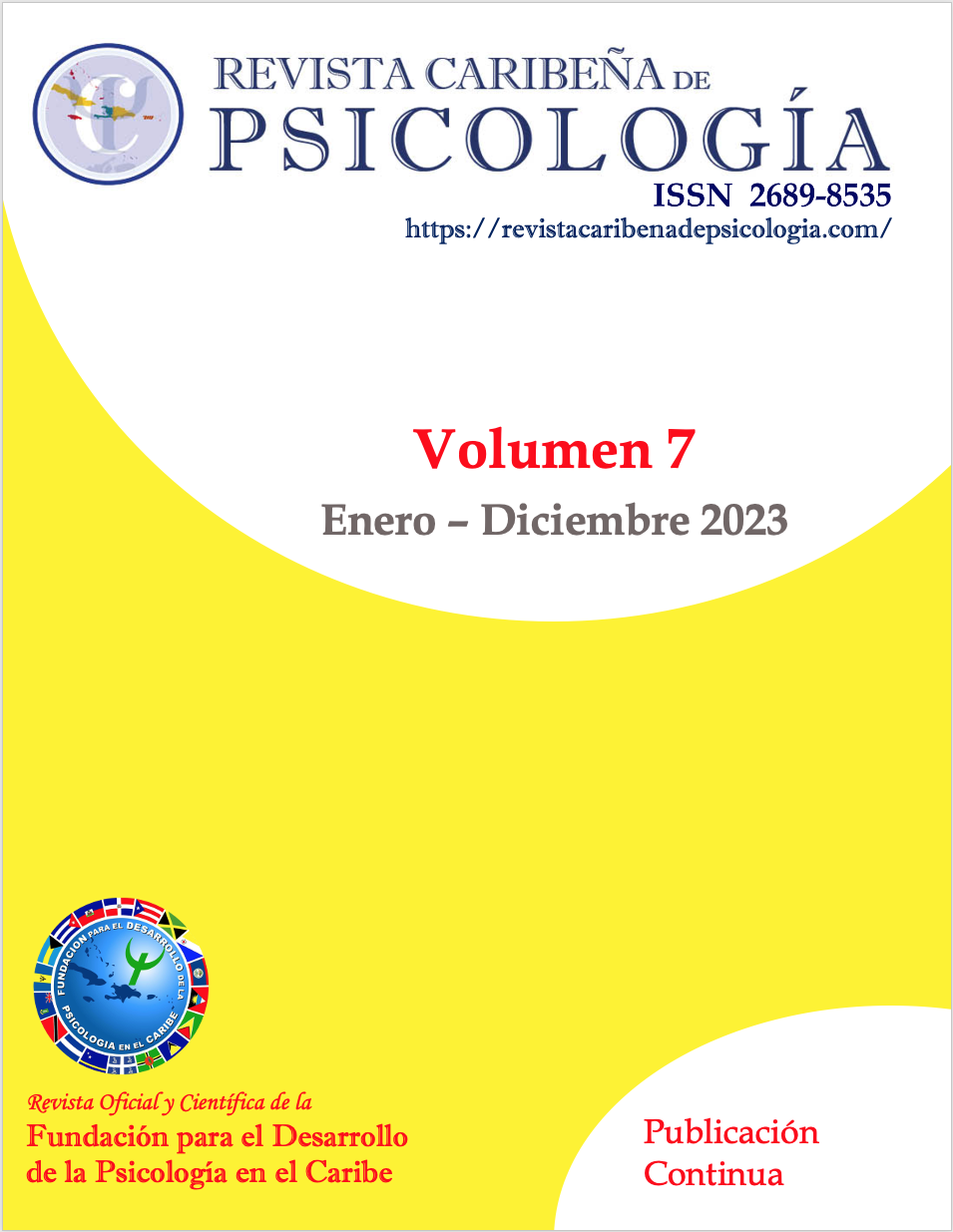Dissociative Experiences Scale - Taxon (DES-T): Evidence of Validity and Clinical Use in Puerto Rico
DOI:
https://doi.org/10.37226/rcp.v7i1.7245Keywords:
assessment, dissociation, Dissociative Experiences Scale, psychometric propertiesAbstract
The DES-T is a modified version of the Dissociative Experiences Scale composed of eight items that precisely measure pathological dissociation: derealization, depersonalization, and identity disturbance. The purpose of the present study was to analyze the psychometric properties of the DES-T and to examine whether belonging to the dissociative taxon indicates pathological dissociation, that is, whether being in the taxon is synonymous with having a dissociative disorder. The study sample was 341 participants. The results reflected that the DES-T has an acceptable internal consistency (α = .87; w = .88) and a unidimensional structure with a good fit. All eight items of the scale met the discrimination criteria. Persons with dissociative disorders scored significantly higher on the DES-T than persons with other mental health disorders. These preliminary results suggest that the DES-T is a reliable and valid instrument for measuring the frequency of pathological dissociation. However, it is concluded that being in the dissociative taxon indicates a higher frequency of dissociative experiences but does not necessarily or categorically indicate the presence of a dissociative disorder.
References
American Psychiatric Association. (2022). Diagnostic and statistical manual of mental disorders (5th ed., text rev.). https://doi.org/10.1176/appi.books.9780890425787
Ato, M., López, J. J., & Benavente, A. (2013). Un sistema de clas-ificación de los diseños de investigación en psicología. Anales de Psicología, 29(3), 1038-1059.
Bernstein, E. M., & Putnam, F. W. (1986). Development, reliabil-ity, and validity of a dissociation scale. The Journal of Nervous and Mental Disease, 174(12), 727–735. https://doi.org/10.1097/00005053-198612000-00004
Byrne, B. M. (2010). Structural equation modeling with AMOS: Basic concepts, applications, and programming. Psychology Press.
Carlson, E. B., & Putnam, F. W. (1993). An update on the Dissoci-ative Experiences Scale. Dissociation: Progress in the Dissociative Disorders, 6(1), 16–27.
DeVellis, R. F. (2017). Scale development: Theory and applications (4th Ed). Sage Publications.
Doornik, J. A., & Hansen, H. (2008). An omnibus test for univari-ate and multivariate normality. Oxford Bulletin of Economics and Statistics, 70(1), 927–939. https://doi.org/10.1111/j.1468-0084.2008.00537.x
Giesbrecht, T., Merckelbach, H., & Geraerts, E. (2007). The disso-ciative experiences taxon is related to fantasy proneness. The Journal of Nervous and Mental Disease, 195(9), 769–772. https://doi.org/10.1097/NMD.0b013e318142ce55
González-Rivera, J. A. (2023). Dissociative Experiences Scale (DES-II): Psychometric Analysis in Puerto Rico and Contributions to the Discussion of the Factor Structure [Manuscript submitted for publication].
Hair, J. F., Black, W. C., Babin, B. J., & Anderson, R. E. (2010). Multivariate Data Analysis (7th ed.). Prentice Hall.
Hankins, M. (2008). How discriminating are discriminative in-struments? Health and Quality of Life Outcomes, 6(1), 36. http://doi.org/10.1186/1477-7525-6-36
Kate, M.-A., Hopwood, T., & Jamieson, G. (2019). The prevalence of dissociative disorders and dissociative experiences in col-lege populations: A meta-analysis of 98 studies. Journal of Trauma and Dissociation, 21(1), 16–61. https://doi.org/10.1080/15299732.2019.1647915
Kline, T. J. (2005). Psychological testing: A practical approach to de-sign and evaluation. Sage.
Leavitt, F. (1999). Dissociative experiences scale taxon and meas-urement of dissociative pathology: Does the taxon add to an understanding of dissociation and its associated pathologies? Journal of Clinical Psychology in Medical Settings, 6(4), 427–440. https://doi.org/10.1023/A:1026275916184
Martínez-Taboas, A. (1995). The use of the Dissociative Experi-ences Scale in Puerto Rico. Dissociation: Progress in the Dissocia-tive Disorders, 8(1), 14–23.
Martínez-Taboas, A., Canino, G., Wang, M. Q., García, P., & Bra-vo, M. (2006). Prevalence and victimization correlates of pathological dissociation in a community sample of youths. Journal of Traumatic Stress, 19(4), 439–448. https://doi.org/10.1002/jts.20144
Martínez-Taboas, A., Shrout, P. E., Canino, G., Chavez, L. M., Ramírez, R., Bravo, M., Bauermeister, J. J., & Ribera, J. C. (2004). The psychometric properties of a shortened version of the Spanish Adolescent Dissociative Experiences Scale. Jour-nal of Trauma & Dissociation, 5(4), 33–54. https://doi.org/10.1300/J229v05n04_03
Merckelbach, H., Rassin, E., & Muris, P. (2000). Dissociation, schizotypy, and fantasy proneness in undergraduate stu-dents. The Journal of Nervous and Mental Disease, 188(7), 428–431. https://doi.org/10.1097/00005053-200007000-00006
Merritt, R. D., & You, S. (2008). Is there really a dissociative taxon on the dissociative experiences scale? Journal of Personality As-sessment, 90(2), 201–203. https://doi.org/10.1080/00223890701845492
Modestin, J., & Erni, T. (2004). Testing the dissociative taxon. Psychiatry Research, 15(1), 77–82. https://doi.org/10.1016/j.psychres.2001.12.001
Montes, S. A., Ledesma, R. D., & Poó, F. M. (2011). Evaluación psicométrica de una versión modificada de la Escala de Expe-riencias Disociativas (DES-M). Revista Argentina de Clínica Psicológica, 20(1), 67-90. https://www.redalyc.org/pdf/2819/281921807006.pdf
Pope, C. A., & Kwapil, T. R. (2000). Dissociative experience in hypothetically psychosis-prone college students. The Journal of Nervous and Mental Disease, 188(8), 530–536. https://doi.org/10.1097/00005053-200008000-00009
Rassin, E., Merckelbach, H., & Spaan, V. (2001). When dreams become a royal road to confusion: Realistic dreams, dissocia-tion, and fantasy proneness. The Journal of Nervous and Mental Disease, 189(7), 478–481. https://doi.org/10.1097/00005053-200107000-00010
Ross C. A. (2021). The Dissociative Taxon and Dissociative Identi-ty Disorder. Journal of Trauma & Dissociation, 22(5), 555–562. https://doi.org/10.1080/15299732.2020.1869645
Ross, C. A., Goode, C., & Schroeder, E. (2018). Treatment out-comes across ten months of combined inpatient and outpa-tient treatment in a traumatized and dissociative patient group. Frontiers in the Psychotherapy of Trauma and Dissociation, 19(5), 87–100. https://doi.org/10.1080/15299732.2018.1451807
Satorra, A., & Bentler, P. M. (2001). A scaled difference chi-square test statistic for moment structure analysis. Psy-chometrika, 66(4), 507-514. https://doi.org/10.1007/BF02296192
Waldo, T. G., & Merritt, R. D. (2000). Fantasy proneness, dissocia-tion, and DSM-IV axis II symptomatology. Journal of Abnormal Psychology, 109(3), 555–558. https://doi.org/10.1037/0021-843X.109.3.555
Waller, N. G., Putnam, F. W., & Carlson, E. B. (1996). Types of dissociation and dissociative types: A taxometric analysis of dissociative experiences. Psychological Methods, 1(3), 300–321. https://doi.org/10.1037/1082-989X.1.3.300
Waller, N. G., & Ross, C. A. (1997). The prevalence and biometric structure of pathological dissociation in the general popula-tion: Taxometric structure and behavior genetic findings. Journal of Abnormal and Social Psychology, 106(4), 499–510. https://doi.org/10.1037/0021-843X.106.4.499
Downloads
Published
How to Cite
Issue
Section
License
Copyright (c) 2023 Juan Aníbal González-Rivera

This work is licensed under a Creative Commons Attribution 4.0 International License.







